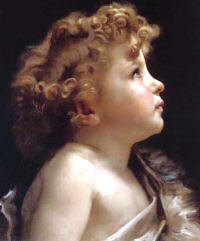Article Tools
- Text Size


- Email this article
The Birth of St. John the Baptist
The Lord called me from birth. (Isaiah 49:1)
What do you think is the most amazing thing about John the Baptist? His zeal for the Lord? His passionate preaching? Maybe his gift of self-denial or the humility he displayed despite his fame?
How about this instead: Even as a fetus, John leapt for joy in the presence of the Virgin Mary because she was carrying the Son of God. John was still an unborn baby, barely aware of life outside of the womb, and yet the muffled, quiet sound of Mary’s greeting filled him with joy.
John’s leap may remind us of Rebecca, who also felt an unusual amount of activity from the twins in her womb. She asked God why this was happening, and he told her that something spiritual and prophetic was going on inside of her (Genesis 25:20-23). King David also leapt before the Ark of the Covenant. He loved God so much he couldn’t contain himself (2 Samuel 6:14-15). The prophet Isaiah wrote that in the age to come, when the glory of the Lord is made manifest, the lame will leap for joy (Isaiah 35:4-6).
John’s joy shows us that there is a part of us that can recognize God, something encoded deep in the way he made us. It’s in all of us, not just the great saints and the unborn. It’s also something that the Holy Spirit wants to bring to life in each of us. He wants to fill us all with joy as we sense the presence of the Lord.
So let’s honor John the Baptist today. As a bridge between the Old and New Testaments, John truly is one of the greatest saints of the church. But let’s never forget that his relationship with Jesus—especially his ability to recognize the Lord and rejoice in him—is something we all can experience. Every one of us can leap for joy as we prepare this world for the coming of Christ the King!
“Lord, I want to see you. Come show yourself to me, and fill my heart with joy.”
Questions for Reflection or Group Discussion
(Isaiah 49:1-6; Psalm 139:1-3,13-15; Acts 13:22-26; Luke 1:57-66,80)
1. The first reading is the second of seven “Servant of the Lord” oracles in Isaiah, which speaks prophetically of the passion and glorification of Christ. In this oracle, we hear these powerful words: “The Lord called me from birth, from my mother’s womb he gave me my name,” “my reward is with the Lord., my recompense is with my God,” and “my God is now my strength.” In what ways do these words also apply to you?
2. In the responsorial psalm, the psalmist speaks of how the Lord “formed my inmost being; you knit me in my mother’s womb.” He goes on to say that he has been “fearfully and wonderfully made.” Similar to the first reading and the responsorial psalm, there are many other Scriptures that speak of how God has formed and called each of us beginning with conception in our mother’s womb. For example, Jeremiah 1:5 says these words: “Before I formed you in the womb I knew you, before you were born I dedicated you.” How would you describe how these Scriptures are related to the strong pro-life teachings of the Church against abortion? How can you use these and other Scriptures in your own pro-life witness?
3. In the second reading, David is called “a man after God’s heart; he will carry out my every wish.” These words could also be easily applied to John the Baptist. What about you? What are the obstacles in your life that keep you from being the same kind of person? What steps can you take to overcome them?
4. In the Gospel reading, which describes the birth of John the Baptist, all the people who witnessed it “were amazed” and his birth “was discussed throughout the hill country of Judea.” Why do you think John’s birth caused such a stir among the people? Does it have the same affect on you? Why or why not?
5. The meditation reminds us that the joy that John the Baptist experienced in the womb of Elizabeth “shows us that there is a part of us that can recognize God, something encoded deep in the way he made us.” It goes on to say that John’s “relationship with Jesus—especially his ability to recognize the Lord and rejoice in him—is something we all can experience.” In what ways has this been true in your own life? Can you give specific examples? What steps can you take to open yourself to experience more deeply the “joy of the Lord”?
6. Take some time now to pray for a greater openness to the “joy of the Lord” in your life. Use the prayer at the end of the meditation as the starting point.
